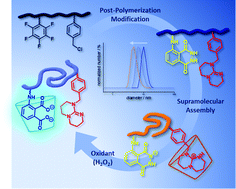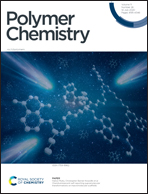Chemiluminescent self-reporting supramolecular transformations on macromolecular scaffolds†
Abstract
We introduce the synthesis of a self-reporting system with chemiluminescent output, which is regulated via dynamic supramolecular complex formation. By free radical polymerization and subsequent post-polymerization modification, a copolymer decorated with luminol and superbase (i.e. 1,5,7-triaza-bicyclo-[4.4.0]dec-5-ene (TBD)) moieties was synthesized, which in turn forms supramolecular host–guest-complexation with randomly methylated β-cyclodextrin (Me-β-CD). Upon hydrogen peroxide addition, the host–guest-interactions with the self-assembly are broken, and the luminol is oxidized to 3-aminophthalic acid (3-APA). Critically, no additional base, buffer or catalyst is required to generate the striking blue light emission of the polymeric system that is detectable by the naked eye. Thus, a fast and easy detection of reactive oxygen species (ROS), such as hydrogen peroxide, under mild conditions is established. The self-reporting system and its chemiluminescent properties are characterized by 1D and 2D NMR spectroscopy (particularly NOESY), dynamic light scattering (DLS), UV/Vis spectroscopy and chemiluminescence (CL) measurements.



 Please wait while we load your content...
Please wait while we load your content...